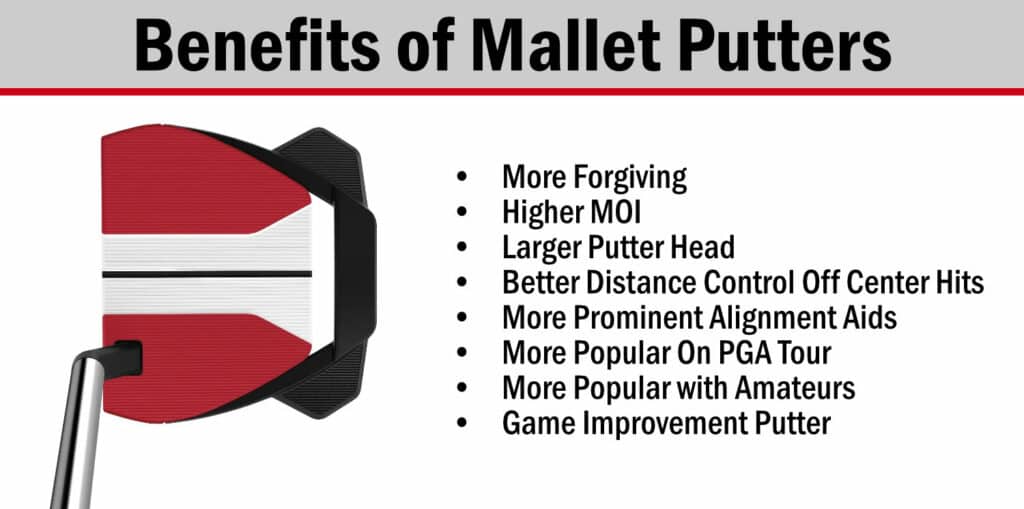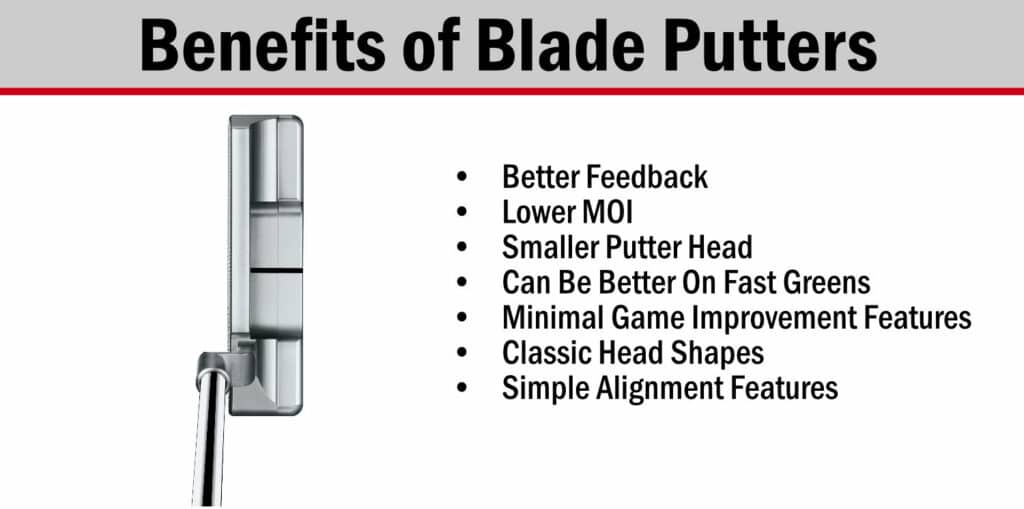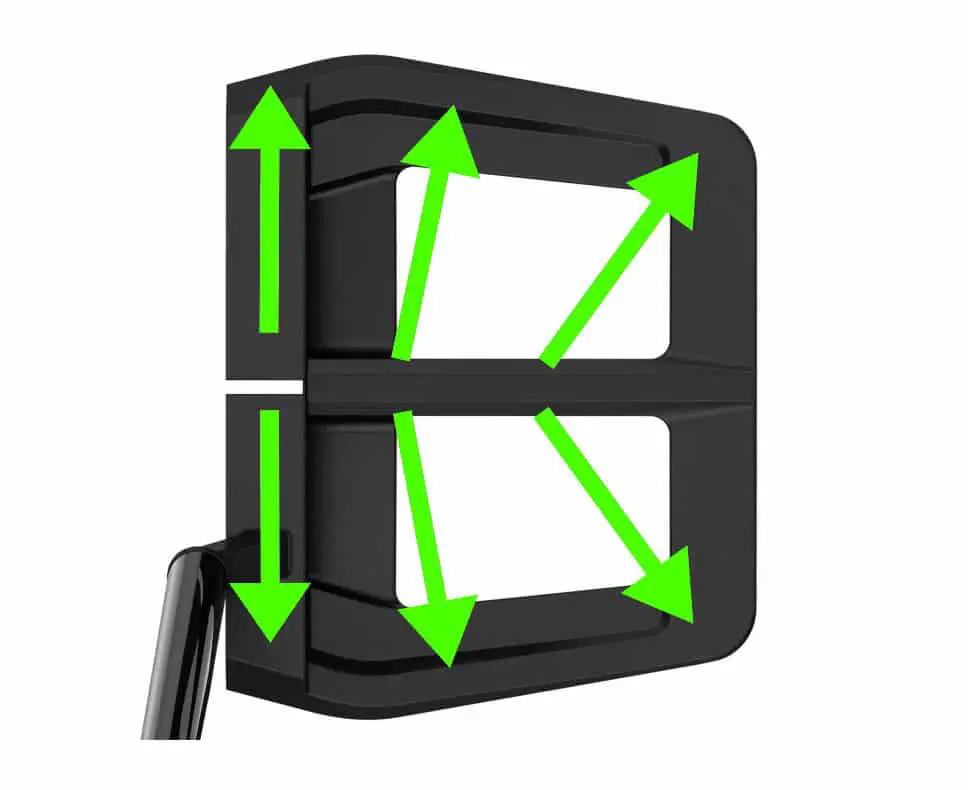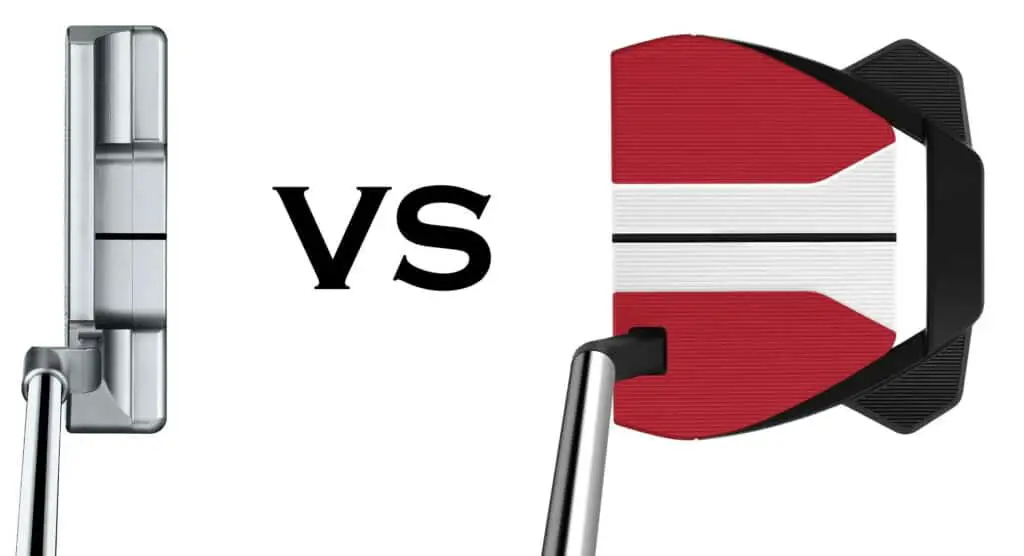Quick Summary
In short, mallet putters have larger heads, they are more forgiving on off-center hits, and they have more powerful alignment aids.
Blade putters offer better feel, better distance control on quick greens, and much simpler putter head designs.
Key Differences
| Blade Putters | Mallet Putters |
|---|---|
| Less Forgiving | More Forgiving |
| Lower MOI | Higher MOI |
| Smaller Putter Head | Larger Putter Head |
| Better Distance Control On Fast Greens | Better Distance Controll Off Center Hits |
| Simpler Alignment Aids | More Prominent Alignment Aids |
| Less Popular On PGA Tour | More Popular On PGA Tour |
| Minimum Game Improvement Technology | Maximum Game Improvement Technology |
Main Features of Mallet Putters

- More Forgiving
- Higher MOI
- Larger Putter Head
- Better Distance Controll Off Center Hits
- More Prominent Alignment Aids
- More Popular On PGA Tour
- More Popular with Amateurs
- Game Improvement Putter
Head Design & Size: Mallet putters have larger and more substantial heads with a more significant amount of weight distributed towards the rear and perimeter. The head shape of a mallet putter can vary widely, but it will always be much larger than the head of a blade putter.
Forgiveness: Mallet putters are generally more forgiving than blade putters. The increased perimeter weighting and size of the head can help stabilize the putter during the stroke, reducing the impact of mishits and providing a more consistent roll.
Prominent Alignment Aids: Mallet putters often feature prominent alignment aids, such as lines, dots, or shapes on the crown of the putter. These aids can help golfers align their putts more accurately.
Weight Distribution: Mallet putters usually have a higher MOI (Moment of Inertia) due to the head’s design. This means they are less likely to twist or turn on off-center hits, which can lead to more accurate putts.
Feel: The feel of a mallet putter can vary, but some golfers find that the larger head and weight distribution provide a softer and more muted feel during the stroke.
Main Features of Blade Putters

- Better Feedback
- Lower MOI
- Smaller Putter Head
- Can Be Better On Fast Greens
- Minimal Game Improvement Features
- Classic Putter Head Shapes
- Simple Alignment Features
Head Design: Blade putters have a more traditional and compact head shape that resembles a blade, hence the name. They have a smaller profile and are often considered more aesthetically pleasing to some golfers.
Feedback: Blade putters tend to provide more immediate feedback, especially to highly skilled golfers. You can feel mishits more clearly due to the smaller sweet spot, which can help with improving consistency, provided you put in the needed practice hours on the putting green.
Better Speed Control: Some golfers prefer the increased control and precision that blade putters can offer. The smaller head and lower MOI actually means that you can make a more aggressive stroke, without worrying about hitting the ball way past the hole. If you play on very quick greens, blade putters can offer better speed and distance control.
Smaller Alignment Aids: Blade putters typically have fewer alignment aids, relying more on the golfer’s ability to visually align the putter to the target.
Weight Distribution: Blade putters usually have a lower MOI compared to mallet putters. This means they may be less forgiving on off-center hits, but skilled golfers who consistently strike the center of the face may prefer the added control.
It Boils Down To Moment Of Intertia (MOI)
- MOI measures how much the putter twists on off-center hits
- MOI is a measurement of a putter face’s resistance on off-center hits
- The higher the MOI, the more resistant the putter is to twisting.
- When you move mass to the toe and heel of a blade putter, that will create more resistance to twisting
- Mallet’s present a larger platform. Mass can be distributed to the corners and sides for even higher MOI.

This particular image is the ultimate key to understanding the difference between a mallet and a blade putter.
It boils down to relatively simple geometry.
With a blade, the weight can only really be distributed between the heel and the toe. While this does improve the MOI of a blade putter, it also demonstrates the limits of working with a long rectangle shape.
With mallet putters, the square/block shape effectively unlocks entirely new areas to distribute the weight. You literally gain access to:
- Heel
- Toe
- Top Side
- Bottom Side
- Top Corner
- Bottom Corner
Why Amateurs Are Better Served By Mallet Putters
Any time you hit a putt with a putter face that isn’t perfectly square, the higher MOI of a mallet putter is an ally. It effectively reduces how much the putter face deviates with an off-center strike.
Importantly, the angle of the putter face at impact is the primary determinant of whether or not the ball starts online. If the putter head twists, the ball is less likely to start on the intended line. The more the putter head twists, the further offline the ball will start.
Based on this, it makes perfect sense to game a putter that twists less rather than more at impact. That is exactly what Mallet putters do.

